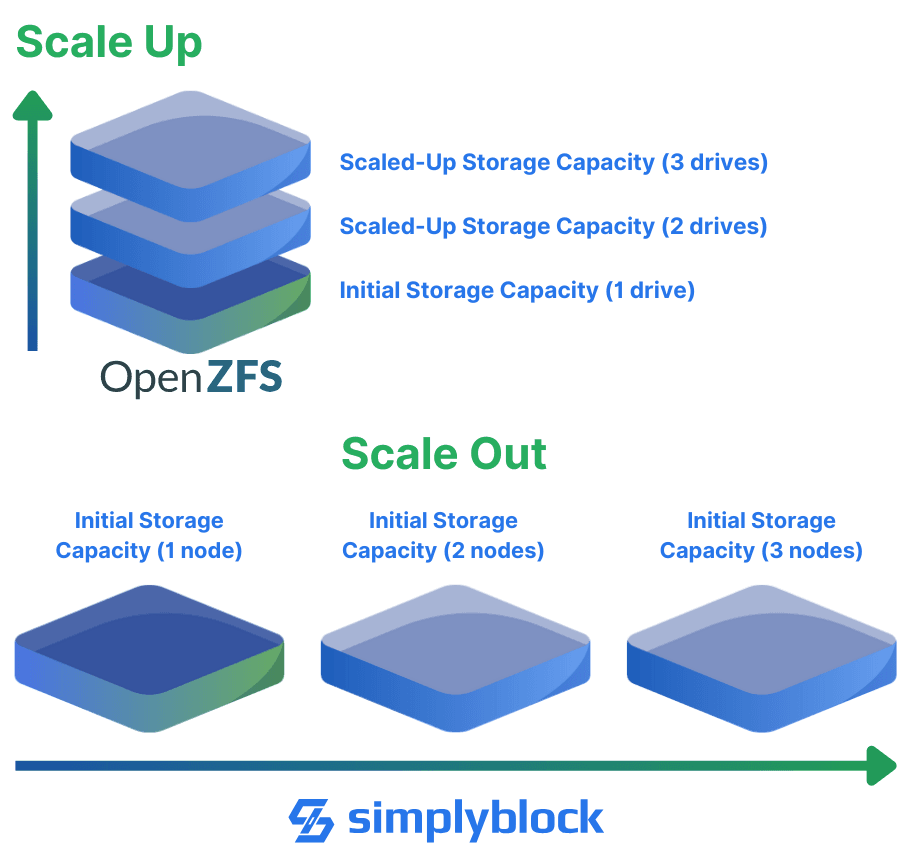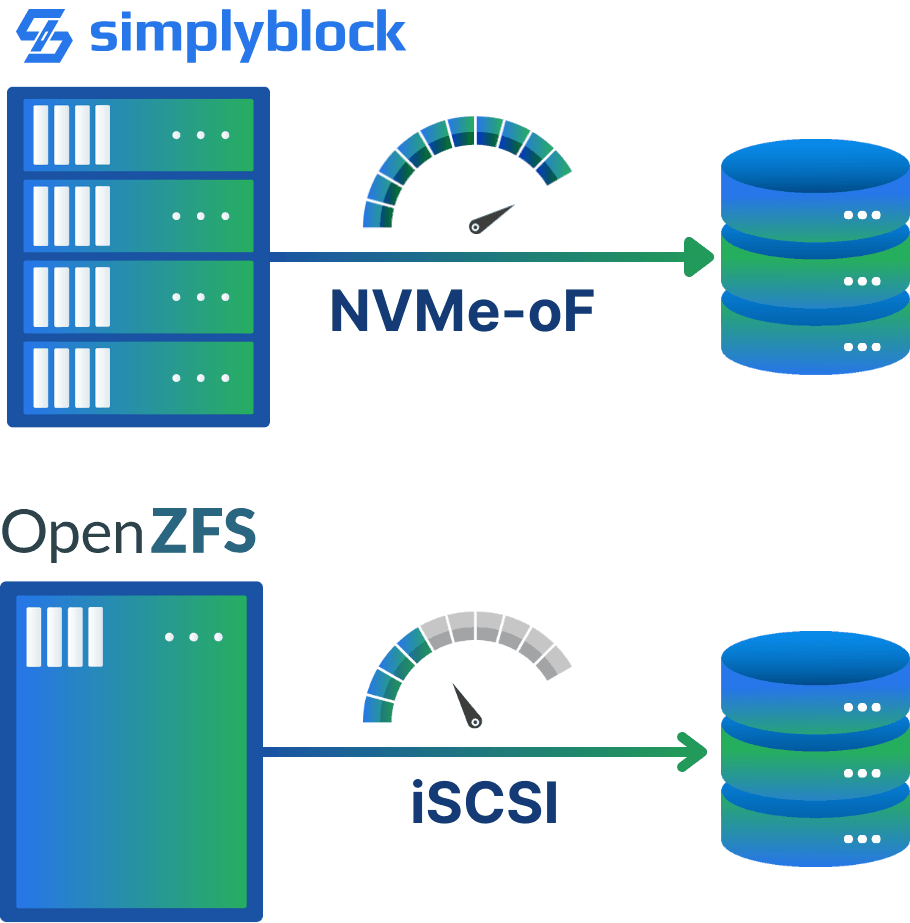ZFS Storage Alternative
Modern scale-out alternative to ZFS
Simplyblock brings all features loved by the ZFS community, such as copy-on-write, thin provisioning, instant snapshots and clones, and automatic tiering, into a scale-out distributed architecture.

Scale-up Only
ZFS is designed to run on a single storage server. Additional storage devices must be added to the same physical server to scale the available storage pool. While there are workarounds, storage capacity requirements will outgrow the possibility of adding additional storage disks.
iSCSI Only
Remote access to ZFS storage is provided via the iSCSI protocol, which transports SCSI commands over Ethernet networks. While iSCSI “gets the job done,” modern flash storage uses the NVMe protocol as its communication layer.
Tuning is Hard
ZFS has hundreds of tuning parameters to optimize its operation to the requested use case. However, tuning these parameters requires in-depth knowledge of ZFS and the underlying hardware.
Designed for Spinning Rust
ZFS was initially designed for spinning disks and is optimized in its read-write behavior to prevent seeking. Therefore, it writes in large batches every few seconds to conserve IOPS and keep read latencies low. Modern flash devices, however, have millions of IOPS and prefer their queues to be as filled as possible.
What is Simplyblock?
With its NVMe-first scale-out architecture, simplyblock’s intelligent storage platform delivers ultra-low latency, automated management, and remote storage access through the modern NVMe/TCP protocol. Unlike ZFS, which can only scale up on a single server, simplyblock is built upon a scale-out cluster architecture to provide the option of adding cluster nodes whenever necessary. With thin provisioning, copy-on-write, instant snapshots and clones, automatic tiering, and more, simplyblock offers all the features that people love about ZFS while not compromising on IOPS, throughput, and access latency.
Deployment Comparison
Simplyblock provides a unified, scalable, and flexible storage solution to pool and manage flash storage devices, spinning disks, and object storage via the modern NVMe over Fabrics protocols. Simplyblock is highly integrated with Kubernetes through its CSI driver. The scale-out storage cluster can run directly in Kubernetes, virtualized, or on Bare-Metal Kubernetes, and can be scaled up and down without downtime.
In contrast, ZFS uses a scale-up-only architecture, limiting the available storage capacity to the physically available space. When using multiple ZFS storage servers, creating a single, unified view is challenging and requires additional components. Additionally, tuning a ZFS storage server for high throughput and low latency is complex and expensive as outside knowledge is commonly needed.


Architecture Comparison
Simplyblock uses an NVMe-first architecture where data is written to a high-performance NVMe storage pool and then transparently tiered to cheaper storage options such as QLC flash or spinning disks. It provides a unified storage virtualization layer to simplify access and management. The virtual storage devices are accessed via NVMe-oF (NVMe over Fabrics), allowing for low access latency and high throughput.
In contrast, ZFS was designed at a time when spinning disks were the norm. While ZFS can be tuned to work well with NVMe-based flash storage, mixed device setups with flash and spinning disks for high capacity and low latency must compromise on both sides due to the available tuning options. ZFS does not support NVMe-oF and must fall back to the older and slower iSCSI protocol.
Benefits of Simplyblock?
Simplyblock provides infinite storage scalability without sacrificing performance or features.
Simplified Operation
Simplyblock abstracts storage complexities and provides a self-healing distributed storage cluster. Via its CLI, API, or management interface, simplyblock enables self-service provisioning and removes operational overhead.
Cost Efficient Scalability
Simplyblock is optimized for NVMe-based storage devices and cost-efficient hardware clusters. With zero-downtime scalability, simplyblock enables storage capacity growth as needed and dramatically reduces the initial cost of storage hardware.
Scale-Out Architecture
Simplyblock enables infinitely storage capacity scalability with its scale-out architecture. Simplyblock storage clusters can scale to hundreds of nodes and provide the combined IOPS and throughput of all cluster nodes for every virtual disk.
More Reasons to Move to Simplyblock
| Simplyblock | ZFS | Details | |
|---|---|---|---|
| Commercial support |
|
| Simplyblock provides commercial support, offering customers a direct line of communication with our expert team. This ensures quick resolution of any issues and ongoing guidance. |
| Unified storage interface |
|
| Simplyblock offers a unified storage interface, providing a consistent experience across different storage tiers and use cases. This eliminates the need to manage multiple storage solutions, simplifying operations and reducing the learning curve. |
| NVMe-optimized deployment |
|
| Simplyblock is designed as an NVMe-first architecture. This ensures a quick initial build-up time for a NVMe storage solutions. |
| Designed for cloud-native |
|
| Simplyblock is purpose-built for modern, cloud-native applications, providing seamless integration with container orchestration platforms such as Kubernetes and microservices architectures. This allows for better alignment with cloud-native development practices. |
| Commercial support | |
|
Simplyblock
|
|
| Simplyblock provides commercial support, offering customers a direct line of communication with our expert team. This ensures quick resolution of any issues and ongoing guidance. | |
| Unified storage interface | |
|
Simplyblock
|
|
| Simplyblock offers a unified storage interface, providing a consistent experience across different storage tiers and use cases. This eliminates the need to manage multiple storage solutions, simplifying operations and reducing the learning curve. | |
| NVMe-optimized deployment | |
|
Simplyblock
|
|
| Simplyblock is designed as an NVMe-first architecture. This ensures a quick initial build-up time for a NVMe storage solutions. | |
| Designed for cloud-native | |
|
Simplyblock
|
|
| Simplyblock is purpose-built for modern, cloud-native applications, providing seamless integration with container orchestration platforms such as Kubernetes and microservices architectures. This allows for better alignment with cloud-native development practices. | |
| Simplyblock | ZFS | Details | |
|---|---|---|---|
| High IOPS density |
|
| Simplyblock enables the full potential of NVMe devices through its NVMe-first scale-out architecture and use of modern storage protocols of the NVMe-oF family. |
| IOPS pooling |
|
| Simplyblock pools the available IOPS of all connected storage devices and shares them across multiple volumes, ensuring optimal resource utilization and performance. It provides QoS and bursting capabilities. |
| Low latency |
|
| Simplyblock forwards the ultra-low access latency of its underlying NVMe storage. This ensures responsive applications and helps to serve use cases such as high-frequency trading. |
| Resource efficiency |
|
| Simplyblock is designed to be cloud-native and resource efficient. CPU and memory consumption are far lower than with ZFS, especially with features such as deduplication. |
| Tiered storage |
|
| Simplyblock enables the tiering of infrequently used data to cheaper storage tiers such as QLC flash, spinning disks, or object storage. |
| High IOPS density | |
|
Simplyblock
|
|
| Simplyblock enables the full potential of NVMe devices through its NVMe-first scale-out architecture and use of modern storage protocols of the NVMe-oF family. | |
| IOPS pooling | |
|
Simplyblock
|
|
| Simplyblock pools the available IOPS of all connected storage devices and shares them across multiple volumes, ensuring optimal resource utilization and performance. It provides QoS and bursting capabilities. | |
| Low latency | |
|
Simplyblock
|
|
| Simplyblock forwards the ultra-low access latency of its underlying NVMe storage. This ensures responsive applications and helps to serve use cases such as high-frequency trading. | |
| Resource efficiency | |
|
Simplyblock
|
|
| Simplyblock is designed to be cloud-native and resource efficient. CPU and memory consumption are far lower than with ZFS, especially with features such as deduplication. | |
| Tiered storage | |
|
Simplyblock
|
|
| Simplyblock enables the tiering of infrequently used data to cheaper storage tiers such as QLC flash, spinning disks, or object storage. | |
| Simplyblock | ZFS | Details | |
|---|---|---|---|
| Cost-efficient servers |
|
| Simplyblock enables the use of cost-efficient server hardware as the storage is scaled across many instances instead of one massive one. |
| Thin provisioning |
|
| Simplyblock supports thin provisioning, which allows users to allocate storage capacity on-demand, reducing waste and improving overall storage utilization. |
| Storage tiering |
|
| Simplyblock enables the tiering of infrequently used data to cheaper storage tiers such as QLC flash, spinning disks, or object storage. |
| Volume consolidation |
|
| Simplyblock provides volume consolidation, enabling users to combine multiple smaller volumes into a single, larger volume. This helps optimize storage capacity and reduce administrative overhead. |
| Deduplication |
|
| Simplyblock's deduplication feature reduces storage consumption by identifying and eliminating redundant data, leading to significant cost savings for customers. |
| Inline Compression |
|
| Simplyblock's inline compression capability further reduces storage costs by compacting data without impacting performance, providing additional efficiency benefits. |
| Cost-efficient servers | |
|
Simplyblock
|
|
| Simplyblock enables the use of cost-efficient server hardware as the storage is scaled across many instances instead of one massive one. | |
| Thin provisioning | |
|
Simplyblock
|
|
| Simplyblock supports thin provisioning, which allows users to allocate storage capacity on-demand, reducing waste and improving overall storage utilization. | |
| Storage tiering | |
|
Simplyblock
|
|
| Simplyblock enables the tiering of infrequently used data to cheaper storage tiers such as QLC flash, spinning disks, or object storage. | |
| Volume consolidation | |
|
Simplyblock
|
|
| Simplyblock provides volume consolidation, enabling users to combine multiple smaller volumes into a single, larger volume. This helps optimize storage capacity and reduce administrative overhead. | |
| Deduplication | |
|
Simplyblock
|
|
| Simplyblock's deduplication feature reduces storage consumption by identifying and eliminating redundant data, leading to significant cost savings for customers. | |
| Inline Compression | |
|
Simplyblock
|
|
| Simplyblock's inline compression capability further reduces storage costs by compacting data without impacting performance, providing additional efficiency benefits. | |
| Simplyblock | ZFS | Details | |
|---|---|---|---|
| Durability |
|
| Simplyblock enables extended data durability up to 99.999%, ensuring the long-term preservation of customer data. |
| Fault tolerance |
|
| Simplyblock's scale-out architecture is designed to be fault-tolerant, provides redundancy and automatic recovery mechanisms to protect against hardware and node failures. Simplyblock volumes can be read-write multi-attached, reattached without delay. They eliminate the need for application downtimes. |
| Efficient data protection |
|
| Simplyblock provides a performance-optimized and distributed erasure coding algorithm. That means the parity information are distributed around the storage cluster. Simplyblock's erasure coding is similar to RAID-Z1 or RAID-Z2 but is more configurable according to actual data protection requirements. |
| Low RPO disaster recovery |
|
| Using a streaming write-ahead log, simplyblock enables near-zero RPO disaster recovery with a low RTO. Disaster recovery can be inside the same data center, or across data centers. |
| Point-in-time recovery |
|
| Using its block-level write-ahead log, simplyblock provides a full point-in-time recovery option that lets you rewind your storage to an earlier point in time, for example, before ransomware has encrypted the drive or before a human-error delete operation. |
| Durability | |
|
Simplyblock
|
|
| Simplyblock enables extended data durability up to 99.999%, ensuring the long-term preservation of customer data. | |
| Fault tolerance | |
|
Simplyblock
|
|
| Simplyblock's scale-out architecture is designed to be fault-tolerant, provides redundancy and automatic recovery mechanisms to protect against hardware and node failures. Simplyblock volumes can be read-write multi-attached, reattached without delay. They eliminate the need for application downtimes. | |
| Efficient data protection | |
|
Simplyblock
|
|
| Simplyblock provides a performance-optimized and distributed erasure coding algorithm. That means the parity information are distributed around the storage cluster. Simplyblock's erasure coding is similar to RAID-Z1 or RAID-Z2 but is more configurable according to actual data protection requirements. | |
| Low RPO disaster recovery | |
|
Simplyblock
|
|
| Using a streaming write-ahead log, simplyblock enables near-zero RPO disaster recovery with a low RTO. Disaster recovery can be inside the same data center, or across data centers. | |
| Point-in-time recovery | |
|
Simplyblock
|
|
| Using its block-level write-ahead log, simplyblock provides a full point-in-time recovery option that lets you rewind your storage to an earlier point in time, for example, before ransomware has encrypted the drive or before a human-error delete operation. | |
| Simplyblock | ZFS | Details | |
|---|---|---|---|
| Commercial support |
|
| Simplyblock provides commercial support, offering customers a direct line of communication with our expert team. This ensures quick resolution of any issues and ongoing guidance. |
| Unified storage interface |
|
| Simplyblock offers a unified storage interface, providing a consistent experience across different storage tiers and use cases. This eliminates the need to manage multiple storage solutions, simplifying operations and reducing the learning curve. |
| NVMe-optimized deployment |
|
| Simplyblock is designed as an NVMe-first architecture. This ensures a quick initial build-up time for a NVMe storage solutions. |
| Designed for cloud-native |
|
| Simplyblock is purpose-built for modern, cloud-native applications, providing seamless integration with container orchestration platforms such as Kubernetes and microservices architectures. This allows for better alignment with cloud-native development practices. |
| Simplyblock | ZFS | Details | |
|---|---|---|---|
| High IOPS density |
|
| Simplyblock enables the full potential of NVMe devices through its NVMe-first scale-out architecture and use of modern storage protocols of the NVMe-oF family. |
| IOPS pooling |
|
| Simplyblock pools the available IOPS of all connected storage devices and shares them across multiple volumes, ensuring optimal resource utilization and performance. It provides QoS and bursting capabilities. |
| Low latency |
|
| Simplyblock forwards the ultra-low access latency of its underlying NVMe storage. This ensures responsive applications and helps to serve use cases such as high-frequency trading. |
| Resource efficiency |
|
| Simplyblock is designed to be cloud-native and resource efficient. CPU and memory consumption are far lower than with ZFS, especially with features such as deduplication. |
| Tiered storage |
|
| Simplyblock enables the tiering of infrequently used data to cheaper storage tiers such as QLC flash, spinning disks, or object storage. |
| Simplyblock | ZFS | Details | |
|---|---|---|---|
| Cost-efficient servers |
|
| Simplyblock enables the use of cost-efficient server hardware as the storage is scaled across many instances instead of one massive one. |
| Thin provisioning |
|
| Simplyblock supports thin provisioning, which allows users to allocate storage capacity on-demand, reducing waste and improving overall storage utilization. |
| Storage tiering |
|
| Simplyblock enables the tiering of infrequently used data to cheaper storage tiers such as QLC flash, spinning disks, or object storage. |
| Volume consolidation |
|
| Simplyblock provides volume consolidation, enabling users to combine multiple smaller volumes into a single, larger volume. This helps optimize storage capacity and reduce administrative overhead. |
| Deduplication |
|
| Simplyblock's deduplication feature reduces storage consumption by identifying and eliminating redundant data, leading to significant cost savings for customers. |
| Inline Compression |
|
| Simplyblock's inline compression capability further reduces storage costs by compacting data without impacting performance, providing additional efficiency benefits. |
| Simplyblock | ZFS | Details | |
|---|---|---|---|
| Durability |
|
| Simplyblock enables extended data durability up to 99.999%, ensuring the long-term preservation of customer data. |
| Fault tolerance |
|
| Simplyblock's scale-out architecture is designed to be fault-tolerant, provides redundancy and automatic recovery mechanisms to protect against hardware and node failures. Simplyblock volumes can be read-write multi-attached, reattached without delay. They eliminate the need for application downtimes. |
| Efficient data protection |
|
| Simplyblock provides a performance-optimized and distributed erasure coding algorithm. That means the parity information are distributed around the storage cluster. Simplyblock's erasure coding is similar to RAID-Z1 or RAID-Z2 but is more configurable according to actual data protection requirements. |
| Low RPO disaster recovery |
|
| Using a streaming write-ahead log, simplyblock enables near-zero RPO disaster recovery with a low RTO. Disaster recovery can be inside the same data center, or across data centers. |
| Point-in-time recovery |
|
| Using its block-level write-ahead log, simplyblock provides a full point-in-time recovery option that lets you rewind your storage to an earlier point in time, for example, before ransomware has encrypted the drive or before a human-error delete operation. |
